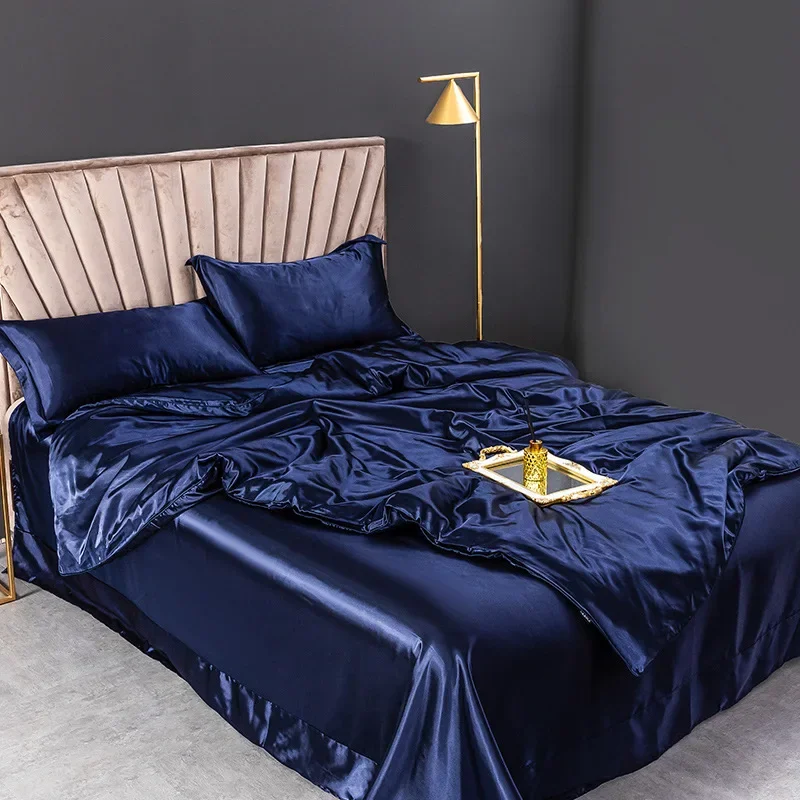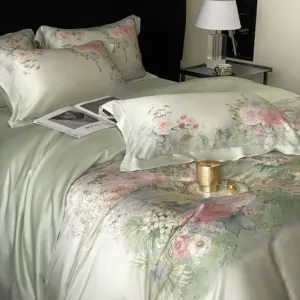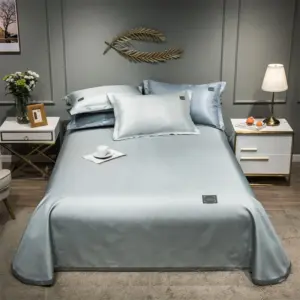Introduction: The Art and Science of Silk Bedding Layers
Creating the perfect bed isn’t just about having quality pieces—it’s about how you layer them together. Layering silk bedding is both an art form and a practical science that can transform your sleep experience. The strategic arrangement of silk sheets, duvets, and complementary textiles creates not just a visually stunning bed, but one that adapts to your body’s needs throughout the night.
Silk stands out among bedding materials due to its remarkable natural properties. Unlike synthetic fabrics, silk regulates temperature exceptionally well, keeping you cool in summer and warm in winter. This protein-based fiber absorbs up to 30% of its weight in moisture without feeling damp, helping maintain ideal sleeping conditions. Its breathable nature allows air to circulate while its incredible softness provides a gentle touch against skin.
The advantages of sleeping on Mulberry silk extend beyond comfort. When layered thoughtfully, silk bedding components work together to create a sleep environment that responds to your body’s changing temperature needs throughout the night. These layers also provide different zones of texture, weight, and insulation that you can adjust according to your preferences.
In this comprehensive guide, we’ll explore everything from selecting the right silk components to mastering seasonal layering techniques. You’ll discover how to pair silk with complementary fabrics, create visually stunning arrangements, and maintain your luxurious sleep sanctuary for years to come. Let’s dive into the world of silk bedding layers and transform your sleep experience.
Understanding Mulberry Silk: The Perfect Foundation for Layered Bedding
Mulberry silk stands as the pinnacle of luxury bedding materials, created from the cocoons of silkworms that feed exclusively on mulberry leaves. What makes Mulberry silk special is its unique composition of natural protein fibers rich in amino acids that benefit both skin and hair. These protein structures give silk its distinctive feel that synthetic alternatives simply cannot replicate.
When selecting silk bedding for layering, understanding momme weight is essential. Momme (pronounced “moe-me”) measures silk fabric density, with higher numbers indicating heavier, more durable silk. For bedding, the ideal range falls between 19-25 momme:
– 19-21 momme: Lightweight yet durable, excellent for warmer climates
– 22-25 momme: Premium weight offering ideal balance of durability and drape
The properties that make silk exceptional for layered bedding include:
- Superior temperature regulation – Silk naturally maintains skin temperature at approximately 98.6°F (37°C), helping you avoid both overheating and chilling
- Moisture-wicking capabilities – Absorbs and releases moisture to keep you dry throughout the night
- Natural hypoallergenic qualities – Resistant to dust mites, mold, and allergens that can disrupt sleep
- Lightweight insulation – Provides warmth without the heavy, restrictive feel of many other bedding materials
- Unmatched drape and sheen – Creates visual dimension in layered bedding with its natural luster
Unlike synthetic “silk” alternatives (typically polyester satin), genuine Mulberry silk contains natural proteins that benefit skin by reducing friction and allowing better moisture balance. When used as the foundation for layered bedding, these qualities create a sleep surface that both looks and feels extraordinary.
Our Mulberry silk bedding sets utilize this exceptional material in its optimal form, providing the perfect starting point for creating your layered silk sanctuary.
Essential Silk Bedding Components for Perfect Layering
Creating the ideal silk bedding arrangement requires understanding each component’s role in the layering system. Each piece contributes unique benefits that, when combined properly, create a harmonious sleep environment tailored to your needs.
Silk Fitted Sheets: As your foundation layer, silk fitted sheets make direct contact with your skin throughout the night. The 22-25 momme weight range provides optimal durability while maintaining silk’s signature softness. These sheets create the initial temperature-regulating barrier between you and your mattress, wicking moisture and allowing your skin to breathe.
Silk Flat Sheets: Whether used as a light cover in summer or as an intermediate layer in colder months, silk flat sheets add versatility to your bedding arrangement. Typically in the 19-22 momme range, these sheets provide a lightweight layer that can be easily added or removed as needed. Their smooth surface glides pleasantly against silk fitted sheets without bunching or creating friction.
Silk Pillowcases: Often overlooked in layering discussions, silk pillowcases are crucial for maintaining the benefits of silk across your entire sleep surface. Beyond supporting skin and hair health, they create visual and tactile continuity across your bed. For the most cohesive look, select pillowcases that match or complement your fitted sheet.
Silk Duvet Covers: These protective outer layers shield silk-filled or alternative duvets while adding another dimension of luxury. Typically crafted from 19-22 momme silk, duvet covers should balance durability with a fluid drape that showcases silk’s natural properties. Their smooth texture reduces friction against other bedding layers.
Silk-Filled Duvets and Comforters: These insulation layers utilize silk’s natural temperature regulation at a larger scale. The momme weight matters less here than fill power and weight, which determine warmth and loft. Silk-filled duvets provide consistent warmth without the “hot spots” common in synthetic alternatives.
Silk Throws and Decorative Elements: The final visual and functional layers add both aesthetics and adaptability to your bedding arrangement. Lightweight silk throws can be folded at the foot of the bed or draped across corners to add visual interest and provide an easy-to-grab extra layer when needed.
Each component should be selected with both individual quality and compatibility in mind. The weight, finish, and color of each piece contributes to both the practical function and visual appeal of your complete silk bedding ensemble.
The Foundation: Proper Mattress Preparation for Silk Layering
Before arranging your silk bedding, preparing your mattress properly ensures that your luxurious layers stay in place and perform optimally. This foundation step prevents common frustrations like slipping sheets and bunched bedding.
Start with a clean, dry mattress surface free of dust and debris. If using a mattress protector—highly recommended to shield your mattress from moisture—choose one with a smooth upper surface. Waterproof protectors with cotton terry tops create friction that helps hold silk in place, while still providing a smooth transition to your fitted sheet.
For enhanced comfort, consider a thin mattress topper that complements silk’s properties. Natural materials work best:
– Thin wool toppers (under 1 inch) provide temperature regulation that enhances silk’s own properties
– Memory foam toppers should be avoided as they can create heat that counteracts silk’s cooling abilities
– Smooth cotton or bamboo toppers create an ideal base that reduces slippage
When applying your Mulberry silk fitted sheet, technique matters significantly. Rather than simply pulling corners down, lift the mattress slightly as you secure each corner to create proper tension across the entire surface. This prevents the sheet from slipping up during the night.
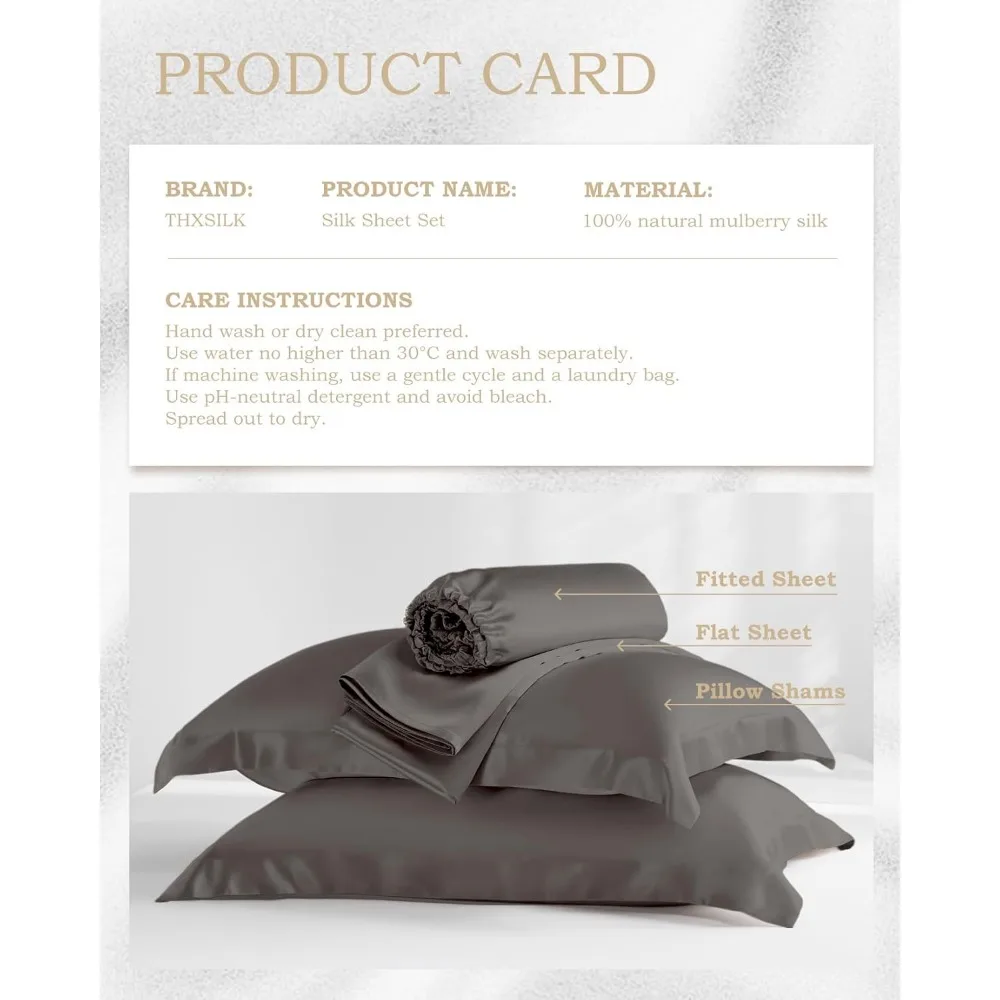
For mattresses with varying profiles, select deep-pocket fitted sheets if your mattress height exceeds 14 inches. The sheet should fit snugly without excessive fabric that could bunch underneath subsequent layers.
Address any static issues before adding additional layers by lightly misting the fitted sheet with a mixture of water and a drop of fabric softener. This reduces static electricity that can cause silk sheets to cling uncomfortably.
The time invested in properly preparing your mattress creates a stable foundation for all subsequent layers, ensuring both the performance and longevity of your silk bedding investment.
The Primary Layer: Mastering Silk Fitted and Flat Sheets
Perfecting the primary bedding layer sets the stage for everything that follows. Mulberry silk sheets require specific techniques to maximize their benefits and overcome their natural slipperiness.
When applying silk fitted sheets, work diagonally rather than on opposite corners. This distributes tension more evenly across the surface, reducing strain on the silk and providing better overall coverage. Ensure the elastic band sits below the mattress edge on all sides for a secure fit that won’t slip during sleep.
For the question of whether to use flat sheets, consider both preference and practicality. In traditional American-style bedding, flat sheets create a barrier between sleeper and duvet, reducing the frequency of duvet cover washing. In European-style bedding, flat sheets are often omitted in favor of directly using a duvet with a washable cover. Both approaches work well with silk, though the additional layer of a flat sheet adds another dimension of temperature control.
When using a flat sheet, the classic “hospital corner” technique requires adaptation for silk:
- Place the flat sheet centered over the fitted sheet with equal overhang on three sides
- Tuck the bottom end under the mattress with light, even tension
- Lift the side of the sheet at a 45-degree angle about 16 inches from the foot of the bed
- Tuck the hanging portion under the mattress while holding the angled section up
- Fold the angled section down and tuck under with very gentle pressure
- Use a lighter touch than with cotton sheets to avoid stressing the silk fibers
To prevent slippage between silk layers, consider these expert techniques:
* Use sheet straps that clip to the underside of your mattress
* Place a thin cotton undersheet beneath your silk fitted sheet if slipping persists
* Select sheets with proper momme weight (22-25) for better drape and stability
The quality of silk makes a significant difference in how well your sheets perform. Evaluating silk sheet quality before purchasing ensures you’re building your bedding layers on a proper foundation.
The Insulation Layer: Silk Duvets, Comforters, and Quilts
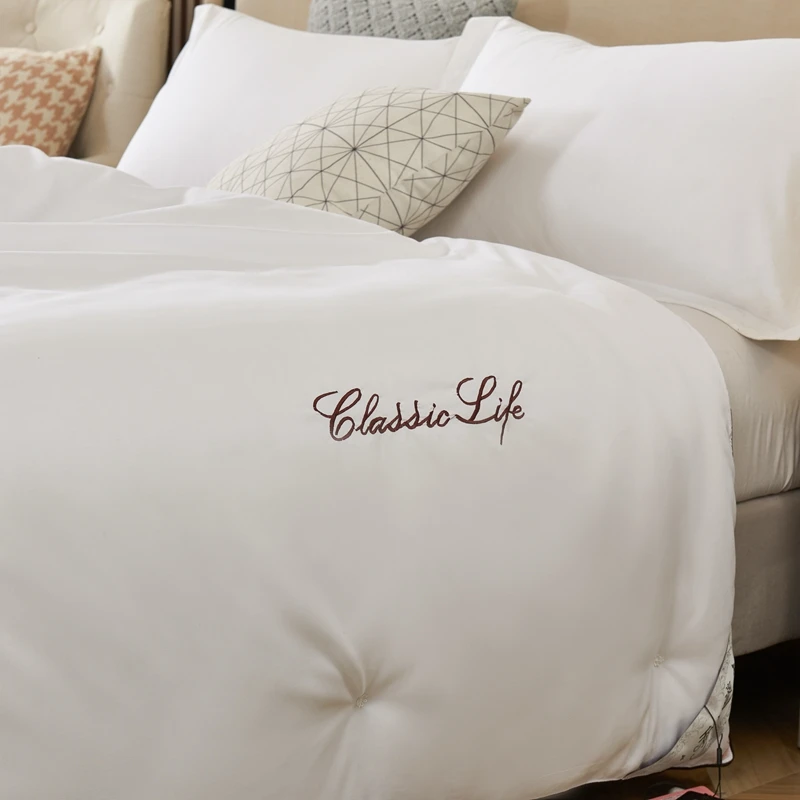
The insulation layer provides the primary warmth in your bedding arrangement, and silk excels in this role due to its remarkable thermal properties. Understanding the options helps you select the perfect insulation for your needs.
Silk-filled duvets differ significantly from silk duvet covers with alternative fillings. True silk-filled duvets contain floss silk—unspun silk fibers that create consistent insulation throughout the duvet. These provide exceptional temperature regulation but typically come at a premium price point. Alternatively, silk duvet covers paired with down, wool, or high-quality synthetic fillings offer more budget-friendly options while still maintaining many of silk’s benefits against your skin.
Fill power indicates the volume one ounce of filling material occupies in cubic inches, directly affecting warmth and loft. For silk duvets, consider:
* Lightweight summer options: 300-400 fill power
* All-season comfort: 400-600 fill power
* Winter warmth: 600+ fill power
Securing your duvet within its cover prevents shifting and bunching. Look for covers with interior corner ties that correspond to loops on your duvet. If these aren’t present, silk-safe safety pins or specialized duvet clips can create the same secure attachment without damaging delicate fabrics.
The drape of silk-filled bedding creates a distinctive profile that gently contours to your body without the excessive loft of down alternatives. This creates a luxurious aesthetic while providing warmth without weight—a key benefit for those who find traditional duvets too heavy.
For year-round comfort, many comprehensive guides to silk bedding recommend investing in two duvets of different weights that can be used individually or fastened together for maximum versatility. This approach allows you to transform sleep quality throughout changing seasons.
When selecting duvet inserts to pair with silk covers, natural materials generally outperform synthetics. Wool inserts provide excellent temperature regulation that complements silk’s properties, while high-quality down offers exceptional loft and insulation. Avoid low-grade polyester fills that create static and counteract silk’s breathability.
Strategic Seasonal Layering with Silk
One of silk’s most remarkable qualities is its adaptability throughout changing seasons. By adjusting your layering strategy seasonally, you maximize comfort while extending the usability of your silk bedding investment.
Summer Layering Strategy (75°F/24°C and above)
During warmer months, minimize layers to capitalize on silk’s cooling properties:
* Begin with a silk fitted sheet in the 19-22 momme range for maximum breathability
* Use either a lightweight silk flat sheet alone or a very lightweight silk-filled summer duvet
* Keep a silk throw folded at the foot of the bed for occasional cool evenings
* Focus on silk’s moisture-wicking abilities to keep you comfortable on humid nights
Spring/Fall Transitional Strategy (55-75°F/13-24°C)
These variable seasons require adaptable bedding arrangements:
* Maintain your silk fitted sheet base layer
* Add a medium-weight flat sheet as your second layer
* Use a mid-weight duvet (400-500 fill power) with silk cover
* Layer a lightweight silk or complementary fabric blanket between sheet and duvet that can be easily removed
* Position an additional throw blanket within reach for unexpected temperature drops
Winter Layering Strategy (Below 55°F/13°C)
Cold weather calls for maximum insulation while maintaining breathability:
* Use a higher momme weight (22-25) silk fitted sheet for its slight added weight
* Include a silk flat sheet as your next layer
* Add a thin blanket of wool or cashmere between sheet and duvet for extra warmth
* Top with a higher fill-power silk duvet (600+) or combine two duvets together
* Consider a silk/wool dual-sided throw for additional warmth that maintains silk against skin
For those sharing beds with partners who have different temperature preferences, consider the “Scandinavian method”—using two twin-sized duvets of different weights on a larger mattress rather than battling over a shared duvet.
The seasonal uses of silk bedding extend beyond simply adding or removing layers. Adjusting the position of layers matters too. In winter, tuck sheets firmly to seal in warmth, while in summer, a looser arrangement increases air circulation.
For particularly hot climates, cooling silk sheets specifically designed to maximize temperature regulation create the perfect foundation for minimal summer layering.
Complementary Textiles: Pairing Silk with Other Premium Fabrics
While silk creates a luxurious foundation for your bedding layers, thoughtfully incorporating complementary fabrics enhances both the functional benefits and aesthetic appeal of your bed. Each fabric pairing brings unique characteristics that can address specific needs or preferences.
| Complementary Fabric | Best Position in Layers | Key Benefits | Ideal Season |
|---|---|---|---|
| Egyptian Cotton (400-800 thread count) | Fitted sheet under silk or duvet cover | Crisp texture contrast, excellent durability | Year-round |
| Linen (175-190 gsm) | Outer decorative layers, summer duvet covers | Enhanced breathability, casual texture contrast | Spring/Summer |
| Cashmere | Thin blankets between sheets and duvet | Exceptional warmth without weight | Fall/Winter |
| Bamboo | Alternative fitted sheets, duvet covers | Similar drape to silk at lower cost | Year-round |
| Organic Cotton | Mattress protectors, sheet alternatives | Sustainability, hypoallergenic properties | Year-round |
High-thread-count Egyptian cotton pairs beautifully with silk, offering a more structured foundation layer when used as a fitted sheet beneath silk layers. The cotton’s crisp finish creates a pleasing contrast against silk’s fluid drape. For those concerned about silk sheets slipping, starting with cotton creates more friction against the mattress while maintaining silk where it contacts your skin.
Linen brings textural interest and rustic elegance when used as a duvet cover over silk-filled inserts or as decorative pillow shams. The natural wrinkles and casual appearance of linen balance silk’s refinement, creating visual depth. This pairing works exceptionally well in warmer months when linen’s exceptional breathability complements silk’s cooling properties.
For winter comfort, layering thin cashmere or merino wool blankets between silk sheets and duvets adds substantial warmth without bulk. These natural protein fibers share many of silk’s beneficial properties while providing additional insulation, making this combination ideal for cold climates.
For those exploring vegan silk bedding options, bamboo offers many similar properties to silk—smooth texture, natural temperature regulation, and beautiful drape—making it the closest plant-based alternative. A silk vs. cotton comparison reveals that while both are natural fibers, silk’s protein structure provides unique benefits that cotton cannot match, though cotton’s durability makes it excellent for foundation layers.
When combining fabrics, consider not just their functional properties but also their care requirements. Grouping materials with similar washing instructions simplifies maintenance and extends the life of your bedding investment.
The Art of Visual Layering: Creating an Aesthetically Pleasing Bed
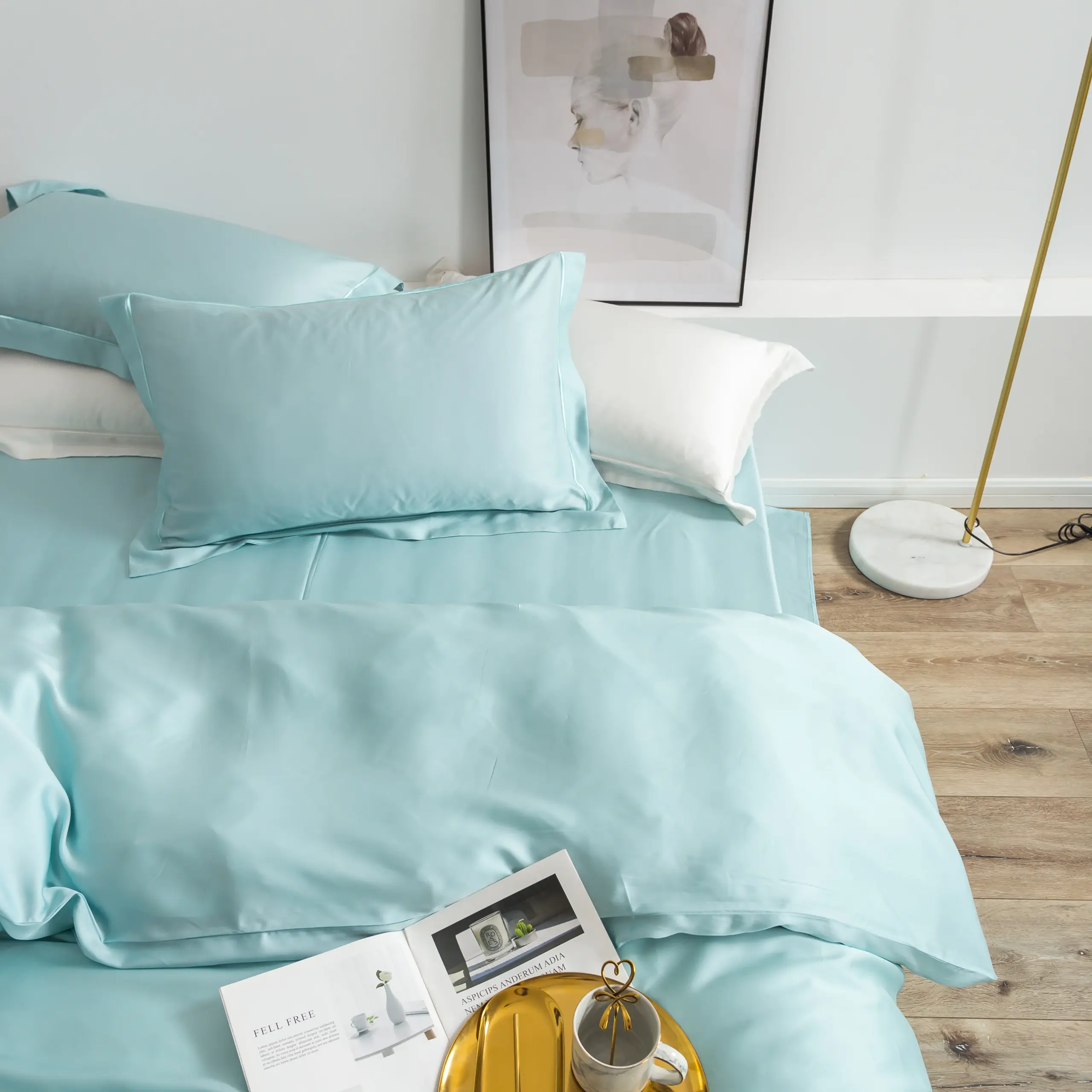
Beyond the functional benefits of layered bedding lies the visual impact of a beautifully styled bed. The natural sheen and fluid drape of silk create unique opportunities for creating a bed that serves as the focal point of your bedroom.
When styling silk bedding, consider these design principles:
Color Theory with Silk
Silk’s natural luster intensifies colors and creates subtle variations as light changes throughout the day. For a harmonious look:
* Use monochromatic color schemes (varying shades of a single color) to showcase silk’s dimensional quality
* Pair neutrals with one accent color to create sophisticated focal points
* Consider how natural and artificial lighting in your bedroom affects silk’s appearance
Creating Visual Texture
Despite silk’s smooth surface, you can create visual texture through thoughtful arrangement:
* Fold duvet covers into thirds across the bottom half of the bed to create depth
* Use the “roll and tuck” method for flat sheets, creating a smooth border above the duvet
* Layer different sized pillows with varying silk pillowcases to create dimension
Pillow Arrangement Techniques
The finishing touch to any well-styled bed comes through thoughtfully arranged pillows:
* European (square) pillows at the back provide height and structure
* Standard sleeping pillows in silk cases positioned in front or stacked
* Decorative accent pillows in complementary fabrics to add interest
* Limit total pillows to 5-7 to avoid overwhelming the silk’s natural elegance
Balancing Minimalism and Luxury
Silk naturally communicates luxury, allowing for more restrained styling:
* For minimalist approaches, focus on fewer layers with impeccable quality and drape
* For maximalist styles, vary textures while maintaining a cohesive color story
* Let silk be the star—pair with more textured fabrics in supporting roles
When styling bedrooms with silk bedding, consider the overall room design. Silk reflects light and can brighten darker rooms, while adding visual softness to contemporary spaces with hard edges.
A well-styled bed should appear effortlessly elegant rather than stiffly formal. The inherent drape of silk creates natural softness, so avoid over-styling with too many tightly tucked elements. Allow the material to showcase its natural properties through gentle folds and subtle gathering.
Advanced Layering Techniques for Ultimate Luxury
For those seeking to elevate their silk bedding experience further, advanced layering techniques borrowed from luxury hotels and sleep specialists create an unparalleled sleep environment.
The “triple sheet” method, adapted for silk bedding, creates a hotel-quality bed with added versatility:
1. Begin with a silk fitted sheet as your foundation
2. Add a silk flat sheet as your second layer
3. Place a thin blanket or lightweight duvet next
4. Cover with a second flat sheet, folded back with the top sheet to create an elegant cuff
5. Top with your main duvet and decorative elements
This arrangement allows you to sleep between sheets while still enjoying the weight and warmth of middle layers, replicating the luxury hotel experience. It also creates a beautiful visual effect when the bed is turned down.
Creating a sleep microclimate—the small environment between your sheets—requires strategic layer placement:
* Position moisture-wicking layers closest to your body
* Place insulating layers farther from your body but within easy reach
* Arrange layers to allow easy adjustment during the night without fully waking
For those with specific health concerns, silk layering offers therapeutic benefits:
* For hot flashes: Create easily removable thin silk layers rather than one heavy duvet
* For circulation issues: Use lightweight silk-filled duvets that provide warmth without restrictive weight
* For sensitive skin: Maximize silk layers touching the skin while using other materials for outer layers
To prevent slippage between silk layers, professional bed-making techniques include:
* Using envelope corners when tucking sheets (similar to gift wrapping techniques)
* Creating slight tension across horizontal surfaces rather than vertical sides
* Placing thin non-slip fabric strips at key points between layers
Luxury silk bedding sets provide perfectly matched components designed to work together in these advanced layering techniques. The exceptional benefits of Mulberry silk sheets are maximized when layers work in harmony rather than competing with each other.
For true luxury, consider the “pillow menu” concept from five-star hotels—providing different pillow options for different sleeping positions, all encased in silk pillowcases that complement your primary bedding layers.
California King Silk Fitted Sheet, King Size Silk Fitted Sheet, Mulberry Silk Fitted Sheet, Queen Size Silk Fitted Sheet
Price range: $120.04 through $390.79 Select options This product has multiple variants. The options may be chosen on the product page100% Silk Sheets, Green Silk Sheets, King Size Silk Bedding Set, Mulberry Silk Bedding Sets, Queen Size Silk Bedding Set
Price range: $1,246.21 through $1,615.22 Select options This product has multiple variants. The options may be chosen on the product pageEucalyptus Silk Bedding Sets, Eucalyptus Silk Sheets
Price range: $360.24 through $393.60 Select options This product has multiple variants. The options may be chosen on the product page- Price range: $267.82 through $306.55 Select options This product has multiple variants. The options may be chosen on the product page
King Size Silk Fitted Sheet, Queen Size Silk Fitted Sheet, Twin Silk Fitted Sheet
Price range: $113.28 through $145.58 Select options This product has multiple variants. The options may be chosen on the product pageBamboo Silk Sheets, Cooling Silk Sheets
Price range: $130.76 through $177.80 Select options This product has multiple variants. The options may be chosen on the product page
Maintaining Perfect Layers: Preventing Slippage and Movement
Even the most beautifully arranged silk bedding requires maintenance to keep layers perfectly positioned throughout the night. Silk’s smooth texture, while luxurious against skin, creates unique challenges for keeping layers in place.
To secure silk fitted sheets to your mattress:
* Use sheet suspenders or bands that clip to sheet edges and run underneath the mattress
* Select fitted sheets with stronger, higher quality elastic around the entire perimeter
* Consider sheets with deeper pockets that wrap further under the mattress
* Place thin non-slip mattress pads between your mattress and fitted sheet
For preventing duvet shifting within covers:
* Use covers with internal ties corresponding to duvet corner loops
* Add aftermarket duvet clips if your pieces lack built-in fasteners
* Shake and redistribute fill each time you make your bed
* Consider duvet covers with zipper rather than button closures for more secure containment
To minimize overall bedding movement:
* Make your bed with the “envelope tuck” technique for flat sheets
* Smooth each layer thoroughly before adding the next
* Create light tension across horizontal surfaces rather than pulling tightly at sides
* Add weight through proper layering rather than tight tucking
For couples with different temperature preferences:
* Consider split-layer bedding—shared fitted sheet with separate flat sheets and duvets
* Use the “Scandinavian sleep method” with individual duvets side by side
* Layer separate throw blankets on each side that can be added or removed individually
Daily maintenance takes just minutes but preserves your careful layering:
* Smooth and retighten layers each morning, paying special attention to corners
* Fluff duvets daily to redistribute fill and restore loft
* Rotate position of your body on the bed to distribute wear evenly
The benefits of maintaining proper silk layers extend beyond aesthetics. For those with sensitive skin using Mulberry silk sheets, properly positioned layers ensure skin always contacts silk rather than other materials that might cause irritation.
Troubleshooting Common Silk Layering Issues
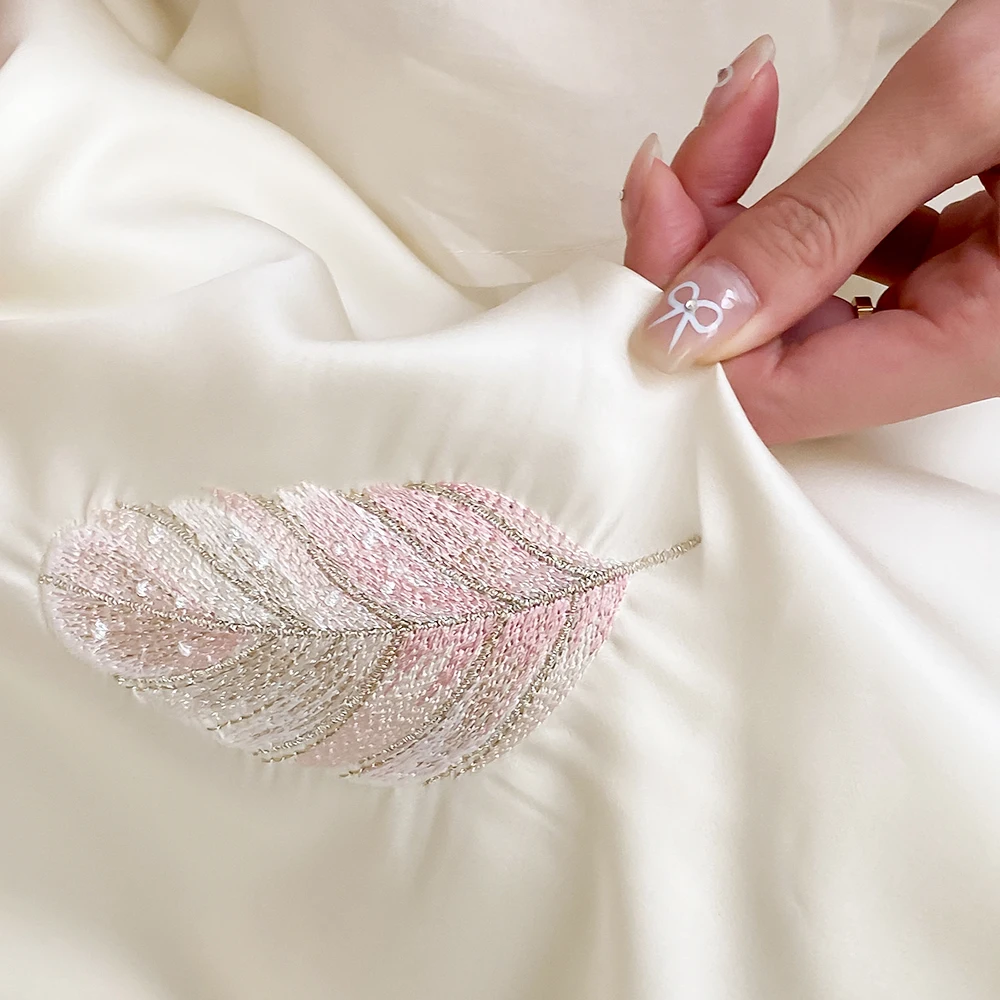
Even with careful selection and arrangement, silk bedding sometimes presents challenges. Here are solutions to the most common issues:
Q: My silk sheets constantly slip off the mattress corners during the night. What can I do?
A: This typically happens because silk has less friction than cotton. Use sheet suspenders that clip to the sheet corners and run beneath your mattress, or try a thin cotton mattress protector underneath your silk fitted sheet to create more grip against the mattress.
Q: I wake up too warm with my silk layers, despite silk’s cooling reputation.
A: You may have too many layers or your silk might be paired with insulating synthetic materials. Ensure your silk layers are closest to your skin, reduce the overall number of layers, and consider using lower momme weight silk (19-21) for your sheets.
Q: Static electricity makes my silk bedding cling uncomfortably.
A: Static builds up especially in dry environments. Lightly mist your silk with a mixture of water and a drop of fabric softener before bed. Also, use natural materials rather than synthetics in your layering system, as synthetics increase static build-up.
Q: My silk duvet cover bunches and shifts, creating uncomfortable lumps.
A: This occurs when the duvet insert moves inside the cover. Look for duvet covers with interior corner ties and inserts with matching loops. If these aren’t present, safety pin the corners (through the duvet tabs, not the silk itself) or use purpose-made duvet clips.
Q: My silk sheets develop deep wrinkles that are uncomfortable to sleep on.
A: Silk naturally wrinkles less than cotton but still requires proper handling. Make your bed while sheets are still slightly damp from washing. Between washings, lightly mist wrinkled areas with water and smooth with your hands. For persistent wrinkles, use a steamer rather than an iron.
Q: The top sheet comes untucked easily despite proper bed-making.
A: Try the “triple tuck” method: tuck the bottom of the sheet, then make diagonal hospital corners, and finally, tuck the sides with extra fabric folded underneath. For a more secure solution, consider sheet fasteners that clip the top sheet to the fitted sheet.
The investment in quality silk bedding is substantial, but choosing Mulberry silk sheets offers benefits that far outweigh these manageable challenges. Most issues can be resolved with simple adjustments to your layering technique rather than compromising on the luxury of silk.
Expert Care Tips for Layered Silk Bedding
Maintaining silk bedding properly ensures your luxury layers remain beautiful and functional for years. Different components of your layered bed may require slightly different care approaches based on their construction and use.
Washing Protocol by Component
For silk sheets and pillowcases (most frequently washed):
* Hand wash or use washing machine’s silk/delicate cycle with cold water (30°F/0°C)
* Use pH-neutral detergents specifically formulated for silk (avoid enzymes, bleach, or brighteners)
* Wash every 7-10 days for items in direct contact with skin
* Always wash dark and light colors separately
For silk duvet covers:
* Follow the same gentle washing process as sheets
* Wash every 4-6 weeks if using a flat sheet underneath, more frequently if not
* Button or zip closures before washing to prevent damage
For silk-filled duvets and comforters:
* Professional cleaning is recommended for most silk-filled items
* If home washing, use front-loading machines only on gentle cycles
* Dry thoroughly to prevent mildew development within filling
* Clean once or twice yearly unless soiled
Drying Techniques
Proper drying preserves silk’s natural properties:
* Air dry whenever possible, laying flat on a clean white towel
* If using a dryer, use air-only setting with no heat
* Remove while still slightly damp (80-90% dry) to prevent wrinkles
* Never hang silk sheets as this can distort the fabric’s shape
Storage Between Seasons
When storing seasonal silk items:
* Ensure pieces are completely clean and thoroughly dry
* Fold gently without sharp creases
* Store in breathable cotton bags rather than plastic
* Place cedar blocks (not mothballs) nearby to deter pests
* Store in a cool, dry place away from direct sunlight
Proper care maintains not only silk’s appearance but also its skin benefits. The natural proteins in silk can be damaged by harsh detergents or improper washing, reducing both the material’s luster and its beneficial properties.
For silk-alternative fabrics in your layered bedding, follow care instructions specific to each material. Generally, natural fibers paired with silk (like cotton and linen) can be washed at slightly higher temperatures than silk itself, though they should still be treated gently for longevity.
Frequently Asked Questions About Layering Silk Bedding
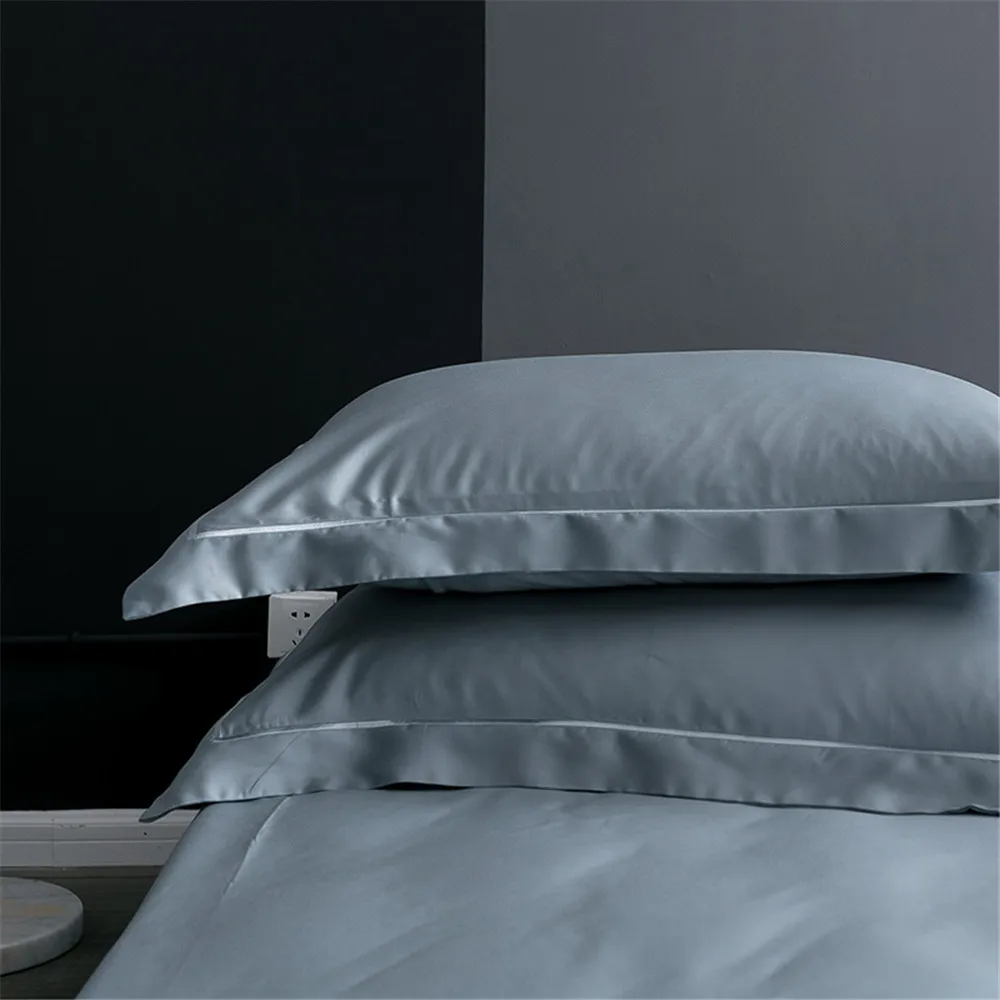
Is investing in silk bedding worth the cost for layering purposes?
Yes, especially when considering cost-per-use over time. Quality silk bedding typically lasts 5-10 years with proper care, making the investment approximately $0.25-0.50 per night for significantly improved comfort and sleep quality. The layering versatility of silk also reduces the need for multiple seasonal bedding sets, creating long-term value.
How many layers of silk are considered optimal?
For most sleepers, 2-4 silk layers provide ideal comfort while maintaining the material’s breathability benefits. This typically includes a fitted sheet, optional flat sheet, duvet cover, and perhaps a decorative throw. Additional layers should be added based on climate needs and personal preference, but excessive layering can compress silk and reduce its insulating properties.
Can silk bedding be used effectively year-round?
Absolutely. Silk’s temperature regulation properties make it uniquely suited for year-round use. In summer, fewer, lighter silk layers wick moisture and allow heat dissipation. In winter, additional silk layers trap warm air while still allowing moisture to escape. This adaptability makes silk more versatile than most other bedding materials.
How do silk bedding layers compare to other luxury fabrics like Egyptian cotton?
While high-quality Egyptian cotton (800+ thread count) offers excellent durability and a crisp feel, silk provides superior moisture-wicking, temperature regulation, and benefits for skin and hair. Cotton absorbs more moisture but takes longer to release it, while silk manages moisture dynamically. For layering, silk’s lightweight nature allows more layers without added bulk compared to cotton.
Are silk alternatives comparable for effective bedding layering?
Synthetic silk alternatives (polyester satin) provide a similar slippery feel but lack silk’s temperature regulation, breathability, and moisture-wicking properties. Bamboo lyocell comes closest to natural silk in performance, offering good moisture management and a smooth feel, though without silk’s protein benefits for skin. For optimal layering, these alternatives can be used for outer layers while keeping true silk closest to the skin.
Do silk sheets work with adjustable beds?
Yes, but with special considerations. Use deep-pocket fitted sheets with strong elastic to accommodate movement. Secure sheets with suspenders or bands that allow flexibility, and consider split-top sheets if the adjustable bed has independent movement on each side. Layering should focus on shorter pieces that won’t get caught in mechanisms.
How do I keep my feet from poking through layered silk sheets?
Use the “footbox fold” technique: create a 12-inch fold at the foot of flat sheets before tucking, allowing extra fabric for foot movement. For those who are tall or active sleepers, oversized flat sheets provide additional length without untucking.
Sustainable and Ethical Considerations for Silk Bedding Layers
As consumers become increasingly mindful of their purchases’ environmental and ethical impacts, understanding silk production and its alternatives becomes important when creating a layered bedding sanctuary.
Traditional silk production involves harvesting silk from cocoons, typically requiring the silkworm to be killed in the process. For those concerned about this aspect, several alternatives exist:
Peace Silk (Ahimsa Silk) allows the moth to emerge naturally before the cocoon is harvested. This process yields slightly less lustrous silk with a different texture that some find equally appealing. When layered with traditional silk components, peace silk adds subtle textural variation while aligning with cruelty-free values.
Certification Standards help identify ethically produced silk. Look for:
* Global Organic Textile Standard (GOTS) – ensures organic production methods
* OEKO-TEX Standard 100 – certifies the absence of harmful substances
* Textile Exchange – promotes responsible silk production practices
From an environmental perspective, silk has both advantages and considerations. As a natural protein fiber, it biodegrades completely, unlike synthetic alternatives. However, conventional silk production can involve chemical processing and significant water usage. Brands implementing water recycling and natural dye processes create more sustainable options.
For those seeking entirely plant-based alternatives, several options work well in layered bedding:
* Bamboo lyocell (not bamboo viscose) offers similar drape and moisture-wicking properties
* Tencel/lyocell derived from sustainable wood pulp provides excellent temperature regulation
* Organic cotton in high thread counts can create a luxurious, if different, feel
When creating a layered bed that balances luxury with ethics, consider:
* Using conventional silk for components that directly touch skin (where benefits are greatest)
* Choosing peace silk or alternatives for decorative outer layers
* Selecting organic, natural materials for complementary pieces
Eco-friendly silk bedding options continue to evolve as manufacturers respond to consumer demand for sustainable luxury. Many now implement closed-loop water systems, natural dyeing processes, and improved worker conditions throughout the supply chain.
By thoughtfully selecting each component of your layered silk bed with both luxury and ethics in mind, you create a sleep sanctuary that aligns with your values while still providing exceptional comfort and beauty.

